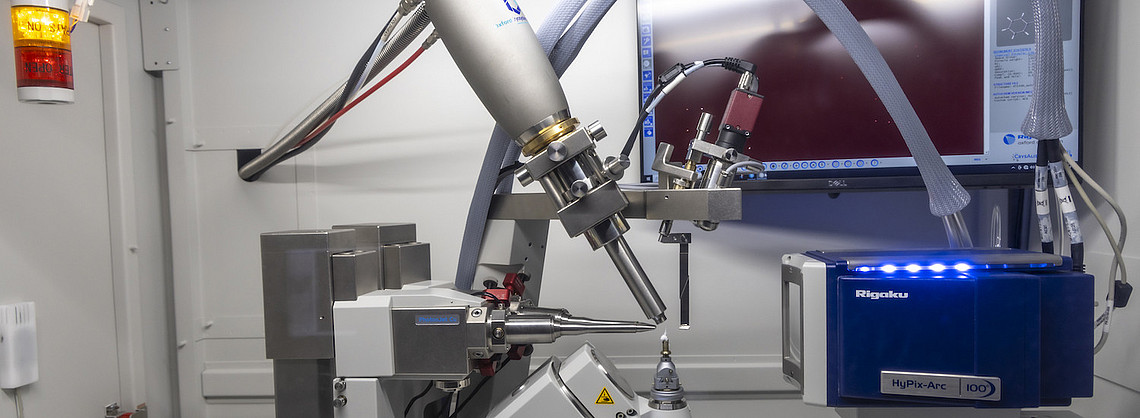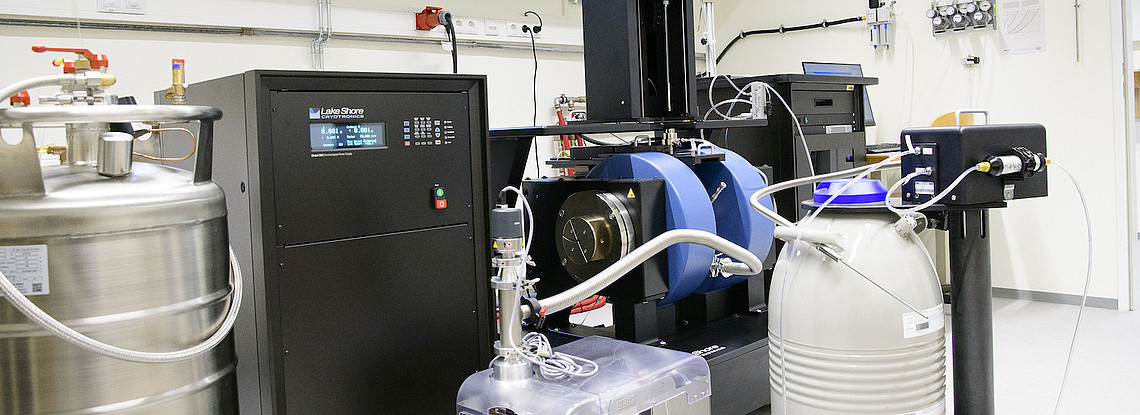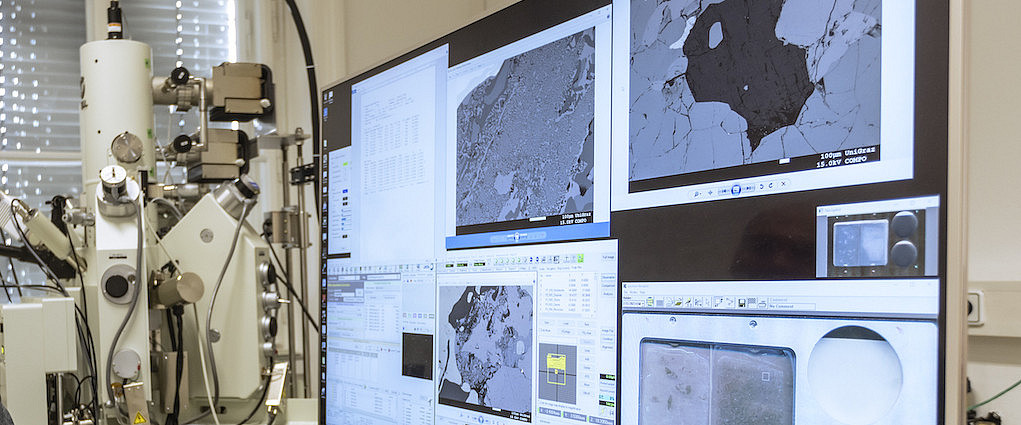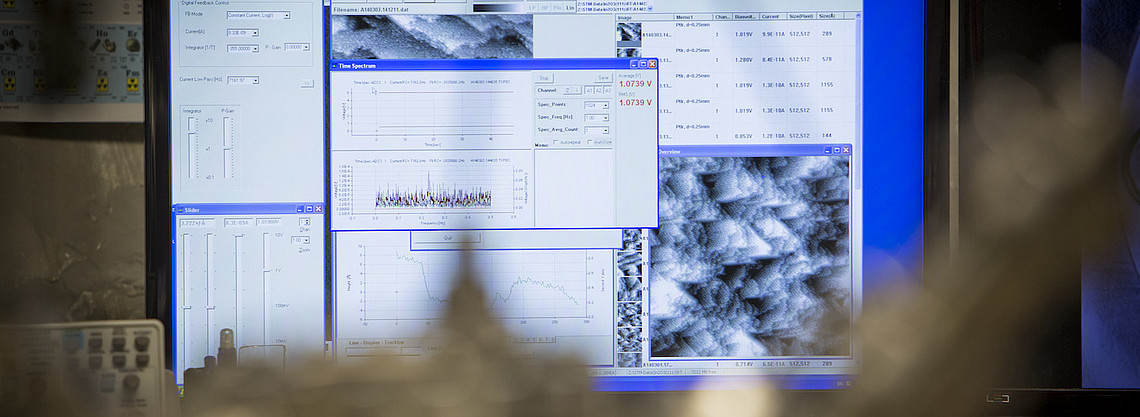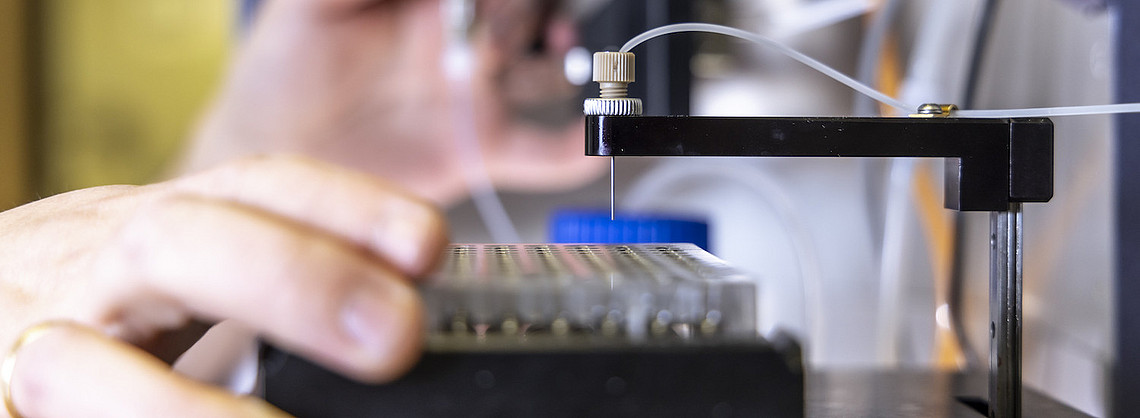Begin of page section: Contents:
NAWI Graz Infrastructure Funding
Research in the natural sciences can only be carried out successfully if the necessary equipment is available. In addition, the availability of equipment is a basic prerequisite for the approval of research project applications.
NAWI Graz quickly recognised this fact and began funding cooperatively used research infrastructure in 2008:
On the one hand, this has led to a higher diversification of the equipment pool, because infrastructure is only purchased once at the location and therefore more instruments can be purchased with the same budget. Moreover, the utilisation of cost-intensive equipment is optimised through the use of researchers from both institutions. And last but not least, the joint use of equipment is a breeding ground for future collaborations.
Initially, the joint acquisition and use of individual devices that were not available in Graz or that were essential or useful additions to existing equipment took place. NAWI Graz infrastructure funds were only used to approve additional financing amounting to a maximum of 50% of the purchase price. In the period from 2008-2015, more than 150 shared instruments were funded.
With a focus on larger networks that bundle researchers even more broadly, the NAWI Graz Central Labs/Core Facilities funding line has been promoted exclusively for several years: Central Labs bring together several thematically related instruments in one place that can be used by all NAWI Graz scientists. This improves the utilisation of the equipment and shortens measurement times. Core Facilities are individual pieces of large-scale equipment that are urgently needed by several research groups.
In the case of Central Labs and Core Facilities, a maximum of 50% is also co-financed from NAWI Graz funds. The multi-stage procedure for the establishment of such large-scale equipment/equipment pools begins with an initial proposal (due to the complexity of such projects, not a formal application, but a concept) from an inter-university initiative group, which - if a positive decision in principle is made - is further developed together with the NAWI Graz Steering Committee.
There are currently over 30 NAWI Graz Central Labs and Core Facilities (see list below, in reverse chronological order)
Direct links to the Central Labs/Core Facilities of the periods:
Other existing core facilities at the scientific location of Graz are listed in the BMBWF research infrastructure database.
Central Labs und Core Facilities Start 2022-24
(jointly acquired with Geosphere Austria and the Austrian Archaeological Institute, ÖAW)
Partners: Prof. Dr. Christoph Hauzenberger (University of Graz) and Prof. Dr. Martin Dietzel (Graz University of Technology)
Due to the high demand for age dating, a Laser Ablation ICPMS (Inductively Coupled Plasma - Mass Spectrometry) was purchased. Laser ablation ICP-MS is a sensitive analytical method for rapid multi-element determination in the trace and ultra-trace range. The device is also a great addition to the Central Lab Water, Minerals and Rocks.
Contact: Assoc.Prof. Dr. Anna Coclite (TU Graz) and Univ.-Prof. Dr. Martin Sterrer
Measuring the contact angle between a liquid and a surface is important to characterize the surface energy and to understand other properties such as aging, surface mobility and wettability. Many new materials require surfaces for which these properties must be known
Contact: Univ.-Prof. Dr. Werner Lienhardt and Univ.-Prof. Tobias Bolch (TU Graz) and Ao. Univ.-Prof. Wolfgang Sulzer (University of Graz)
An Optical Distributed Sensor Interrogator transmits optical waves into an optical fiber (up to 100m) that runs along an object (e.g. a bridge) and determines strains on the surface and inside the object with a resolution of <= 5mm and a frequency of 250 Hz based on the reflection behavior. Thus, the measurement along a fiber can provide the same information as 20000 strain gauges. The changes identified with the device can be cracks in concrete or rock, for example. The device can also detect vibrations during dynamic measurements.
Contact: Prof. Dr. Birgitta Schultze-Bernhardt (Graz University of Technology) and Prof. Dr. Peter Banzer (University of Graz)
This special laser combines two ultrashort pulse lasers within one laser resonator. This makes the double comb particularly stable, low-noise and compact. The exceptionally high pulse repetition rate of 1GHz enables extremely fast data acquisition. It is suitable for dual comb or dual comb Raman spectroscopy in the laboratory, but is also compact enough for use in the field.
Central Labs und Core Facilities Start 2019-21
Contact persons: Ao Univ.-Prof. Dr. Roland Resel (TU Graz) and Ass.-Prof. Dr. Stefan Kowarik (Uni Graz),
X-ray texturgoniometers make it possible to qualitatively and quantitatively determine the preferred orientation of crystals. The focus is on thin layers (up to 30nm) of organic films of molecular crystals, polymers and liquid crystals. In order to achieve the best expertise in this field, there is cooperation between materials scientists, pharmacists, thin-film experts, electronics engineers and other international partners.
Partners: Prof. Dr. Walter Kurz (University of Graz) and Prof. Dr. Martin Dietzel (Graz University of Technology)
This core facility combines analytical capabilities for continuous flow and elemental analyzer isotope ratio mass spectrometry to analyze stable isotope ratios of hydrogen, carbon, oxygen, nitrogen and sulfur. This makes it possible to analyze stable isotopes in various geological, hydrological and biological samples. The Core Facility offers the possibility to investigate geochemical, biochemical, hydrological and climatic processes in basic and applied research within the earth, environmental and climate sciences.
Partners: Dr. Klemens Rumpf (University of Graz) and Prof. Dr. Roland Würschum (Graz University of Technology)
The Vibrating Sample Magnetometer operates in the range ± 3.2 T and allows fast measurements with high sensitivity. Magnetization measurements can be performed as a function of the applied field or temperature. The sample temperature can be varied in a wide range from 4.2 - 1273 K, while the sample magnetization can be measured simultaneously parallel and perpendicular to the applied field and as a function of the angle of rotation. In addition, magnetoresistance measurements are possible in a temperature range between 100 and 673 K.
Partners: Prof. Dr. Steffen Birk (University of Graz) and Prof. Dr. Martin Dietzel (Graz University of Technology)
Especially in the geosciences, which are strongly characterized by field research, mobile devices are an ideal acquisition. NAWI Graz has therefore funded the purchase of fluorescence spectrometers. The devices are used for labeling experiments of fluorescence tracers and detection and degradation of PASP
Central Labs und Core Facilities Start 2016-18
Partners: Prof. Dr. Christoph Hauzenberger (University of Graz) and Prof. Dr. Martin Dietzel (Graz University of Technology)
In recent decades, modern geosciences have evolved into a quantitative natural science. Important progress has been made in the spatially high-resolution analysis of elements. Field emission microprobes enable chemical analyses with a spatial resolution in the nanometer range. This opens up completely new fields of work in geosciences, physics, chemistry, archaeology/archaeometry, materials science and much more. The operation of a field emission microprobe at the Graz site is therefore an ideal extension for the existing NAWI Graz Central Lab for Water, Minerals and Rocks.
Partners: Prof. Dr. Martin Schultze (Graz University of Technology) and Prof. Dr. Martin Sterrer (University of Graz)
The photoemission electron microscope is an ideal add-on to the bundled expertise in electron microscopy and nanostructuring in order to investigate and control the temporal sequence of processes on the lateral nanometer scale: e.g. How quickly is light irradiation converted into other energy within a nanostructure? How quickly does the electron transfer of a catalyst built on nanostructures to a "docked" molecule take place?
Partners: Prof. Dr. Peter Macheroux and Prof. Dr. Bernd Nidetzky (Graz University of Technology), Prof. Dr. Karl Gruber and Prof. Dr. Wolfgang Kroutil (University of Graz)
The origin of many diseases, the mode of action of drugs or the efficiency of enzymes in biotechnology are determined by the interactions between proteins, nucleic acids, enzymes with their substrates and other biomolecules. The Central Lab "Analytical methods for the characterization of bio-molecular interactions" combines novel optical and thermodynamic methods to investigate the interactions of biomolecules.
Partners: Ao. Univ.-Prof. Dr. Günther Zellnig (University of Graz) and Assoc.Prof. Dr. Andreas Winkler (TU Graz)
The upgrade of the existing TEM to a cryo-TEM instrument with a high-resolution camera system allows a significant extension of the resolution range, which is necessary to investigate biological samples (e.g. proteins and protein complexes, membrane proteins, viruses, 2D crystals, ...) under almost native conditions at cryogenic temperatures and without chemical modifications and to document them by means of a high-resolution/high-sensitivity camera system. In addition, the cryo-TEM system enables the testing of various preparation methods (buffer and freezing conditions) and difficult sample preparation on site.
Partners: Assoc. Prof. Dr. Markus Koch (TU Graz) and Ao. Univ.-Prof. Dr. Joachim Krenn (University of Graz)
The Core Facility combines ultrafast laser spectroscopy with optical microscopy with the aim of investigating nano- and quantum materials with femtosecond time resolution and nanometer spatial resolution. The understanding of ultrafast processes in condensed matter has a direct impact on important applications with societal relevance. Ultrafast processes play a key role in the conversion of solar energy into other forms of energy, both in photovoltaics and in hydrogen production by photocatalytic water splitting. Femtosecond dynamics also determine the development of quantum dots as efficient single-photon light sources, which are a basis for the realization of quantum technologies.
Central Labs und Core Facilities Start 2013-15
Contact persons: Ao. Prof. Dr. Joachim Krenn (University of Graz) and Prof. Dr. Gerald Kothleitner (Graz University of Technology)
With this Core Facility, a major gap in instruments in the field of nanosciences was closed in 2015. Many key research questions concern the 1-10 nm range, which is difficult to develop technologically. The new electron beam nanolithography system not only covers this range, but is also capable of structuring larger areas (cm2). The initiative for this core facility is based on a long institutionalized cooperation between TU Graz and the University of Graz in this field.
Contact: Prof. Dr. Ronald Kühnlein (University of Graz)
With regard to the ethical aspects of research, a separate professorship was created in Graz to strengthen alternative model organisms. Using the fruit fly (Drosophila), this core facility investigates questions relating to energy and fat metabolism. This means that classic model organisms such as mice and rats are used less frequently.
Contact persons: Ao. Prof. Dr. Walter Keller (University of Graz) and Prof. Dr. Peter Macheroux (Graz University of Technology)
The Core Facility Spectral Polarimeter expands the existing equipment pool in the field of bioscience for the characterization of macromolecules such as proteins, peptides and nucleic acids. The instrument enables the high-precision and rapid elucidation of secondary structures of dissolved proteins, efficient compartment determination and the biophysical characterization of macromolecules with regard to their thermal and chemical stability as well as their interaction with ligands.
Contact: Inorganic Chemistry (Monika Filzwieser), TU Graz
For some time now, the Institute of Inorganic Chemistry at TU Graz has been offering C7H/N7S elemental analysis as a service for the site. Through NAWI Graz it was possible to renew and expand the existing equipment pool.
Contact persons: Ao. Prof. Dr. Walter Keller (University of Graz) and Prof. Dr. Peter Macheroux (Graz University of Technology)
The Core Facility consists of a Multi Angle Light Scattering (MALS detector), an upgrade to an existing chromatography system for the purification of proteins, peptides and nucleic acids for coupling to an HPLC system. This combination of devices makes it possible to precisely determine the oligomeric state of protein samples and their molecular weight.
Partners: Prof. Dr. Leonhard Grill (University of Graz) and Prof. Dr. Martin Schultze (Graz University of Technology)
The comprehensive analysis of samples often requires measurements with different devices (e.g. scanning probe microscopy, photoemission spectroscopy, desorption spectroscopy). This is the only way to obtain all the required physical and chemical characteristics. The Core Facility allows samples to be sealed in a vacuum case. This ensures that the samples are not contaminated or altered when they are moved to another measuring device or even to a different location.
Central Labs und Core Facilities Start 2010-12
Contact: Prof. Dr. Martin Dietzel (Graz University of Technology) and Prof. Dr. Walter Kurz (University of Graz)
The NAWI Graz Central Lab for Water, Minerals and Rocks is based on an initiative of the Earth Sciences and was launched in 2011. In this Central Lab, the formation and decay of minerals, as well as the age and chemistry of planet Earth, are investigated. The sensitive samples for the experiments and analyses are prepared in a clean room. In 2012, a Multi Collector Inductively Coupled Plasma Mass Spectrometer (MC-ICP-MS) was installed as an extension, making it possible to determine the concentration and mass of atoms in water, minerals and rocks.
Contact: Assoc. Prof. Dr. Tobias Eisenberg (University of Graz) and Assoc. Prof. Dr. Harald Pichler (Graz University of Technology)
In the course of 2013, GRACIA, a central lab for fluorescence-based high-throughput cell analysis, was set up in its first expansion stage. This consists of a high-throughput cell analyzer (BD LSRFortessa), a cell sorter (BD FACSAria II) and server systems for evaluating and storing the data obtained. In combination with the existing expertise in Graz, this provides a unique opportunity to conduct systems biology at a functional level. The causes of disorders of human lipid metabolism and neurodegenerative diseases such as Alzheimer's or Parkinson's can also be identified and characterized more quickly using model organisms and high-throughput screens of substances and genes.
Contact persons: Assoc. Prof. Dr. Georg Raber (University of Graz) and Univ.-Prof. Dr. Gabriele Berg (TU Graz)
Since 2012, the NAWI Graz Central Lab Environmental, Plant & Microbial Metabolomics has been bringing together research groups from the biosciences, chemistry and pharmacy. The aim of the Central Lab is to research the chemical structures of plant and microbial ingredients, as well as their biological effects and impact on the environment. The central analytical instrument of the Central Lab is a high-resolution MS coupled to a UHPLC.
Contact: Prof. Dr. Viktor Hacker (Graz University of Technology) and Dr. Sigurd Schober (University of Graz)
The aim of this Central Lab is to make biomass such as algae, wood or even food waste completely recyclable. The challenge: if, for example, fiber plants or deciduous and coniferous woods are to be used as a raw material basis for various synthesis processes, their rigid structure must be broken down using process engineering. The thermal and chemical stresses involved result in up to 50 percent by-products that are currently not recyclable. Interdisciplinary working groups from Graz University of Technology, Graz University of Technology and Joanneum Research are joining forces to develop new technologies with which biological raw materials such as algae or plant fibers can be fully utilized for the production and isolation of natural substances, active ingredients and various basic chemicals.
Contact: Prof. Dr. Peter Grabner (Graz University of Technology) and Prof. Dr. Gundolf Haase (University of Graz)
The establishment of the joint Bachelor's degree course in Mathematics required a number of investments, which were implemented in the form of a core facility. The Teaching Center Mathematics thus includes a lecture hall extension, the establishment of learning rooms for students and also the expansion of the existing e-book library for students as well as lecturers.
End of this page section. Go to overview of page sections
End of this page section. Go to overview of page sections
